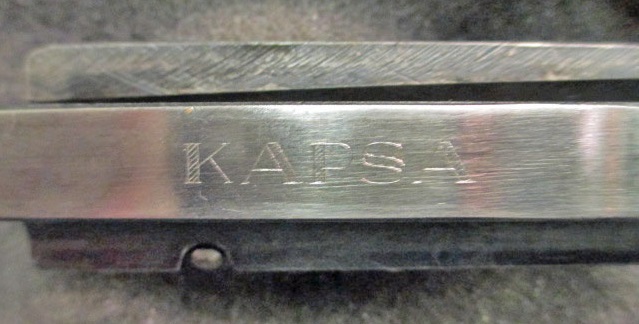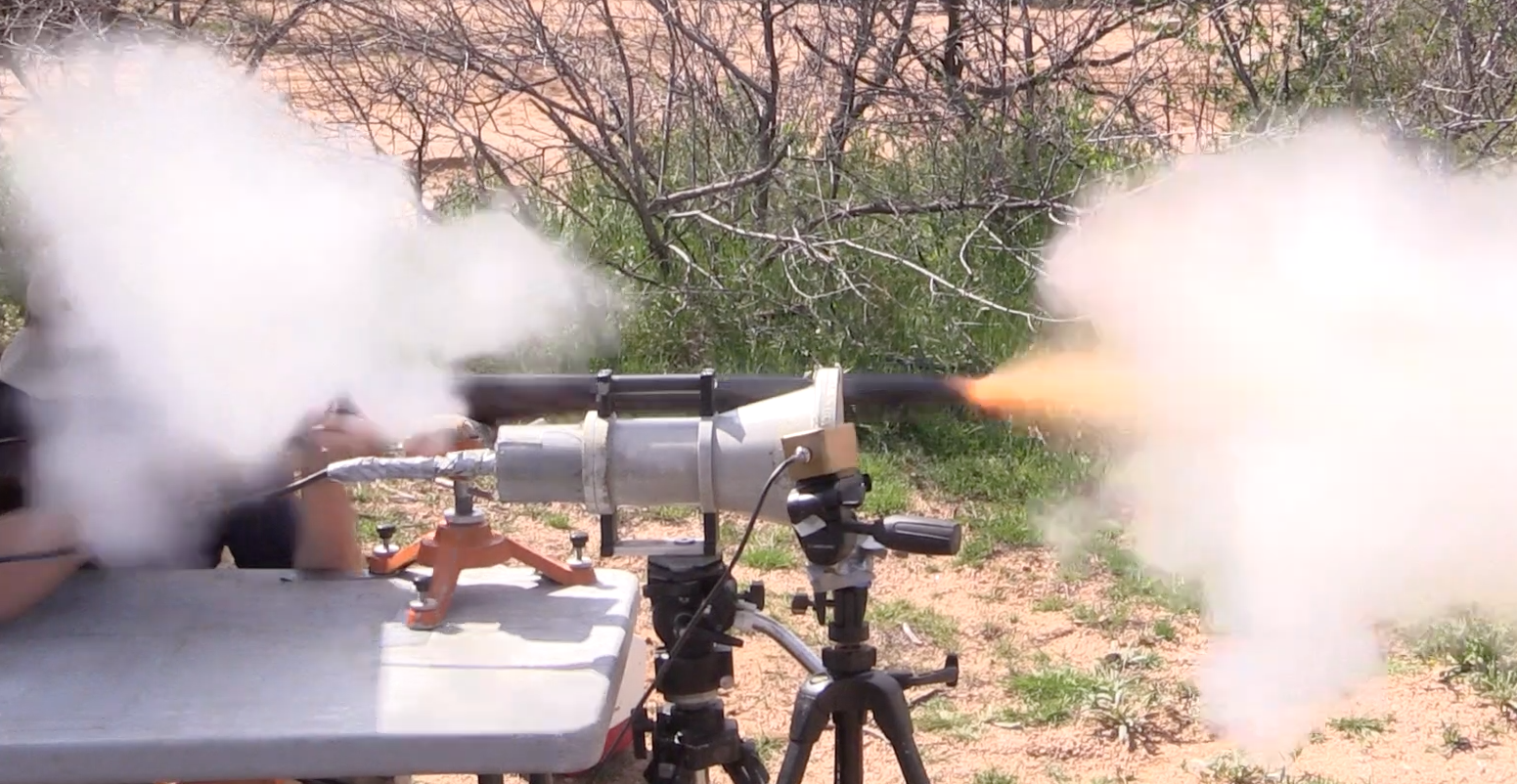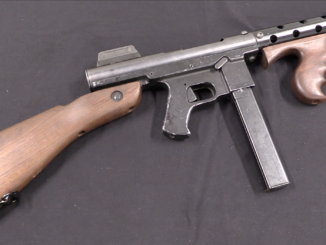I only have two questions this week – if you have something you’re curious about, don’t be shy! Email me at admin@forgottenweapons.com and ask away, so we have enough question to keep this going as a regular feature. Questions don’t have to be super exotic – remember that if you are wondering about something, there are likely a bunch of other people who would like to know the answer as well.
Question #1
First up for today is from a fellow who has a live and registered MP43 with an unusual bit of engraving on the bottom surface of the bolt (visible when looking up through the magazine well:

I showed the photo to a couple acquaintances who are generally considered experts on the MP43/44/StG44 series of rifles, and nobody was able to identify it. The overall conclusion was that it is not of WWII German origin, and likely not of any formal military origin. The word “KAPSA” isn’t something a German word, and doesn’t fit and known acronym or abbreviation used by Germany (or East Germany, post-war). In addition, the style of the engraving is much too decorative to have been a wartime element. It seems most likely that the engraving was done by an individual gunsmith in the US, although the reason for it is not clear. Perhaps this was an owner’s name? Unfortunately, we can’t say with any degree of certainty.
Question #2
The M60 had a longer operating rod did this remove the need for the “fancy chamber” on the Fg42, if so how did SMG Guns manage to avoid said chamber without a longer action. Is there gas port enlarged i.e. to lose more gas in relation to it’s muzzle velocity or?
This was something I asked Rick at SMG when I first got my hands on one of their FG-42 rifles. When Louis Stange originally designed the gun, he had to go through some geometric gymnastics to design a special chamber that would allow the cartridge case to maintain a seal during the first bit of extraction, so as to keep the rifle from being damaged by the high-pressure gas in the chamber at that moment. SMG decided to make an attempt to redesign the action for a normal chamber, so that they could use regular barrels and also to avoid making fired brass unusable. Talking to Rick, it is clear that it wasn’t a simple or quick process to make that adaptation.
The thing to remember is that the FG-42 was developed extremely quickly, and the farther the development got, the more dire Germany’s need for the rifles. SMG had the luxury of being able to experiment with the action without the distraction of aerial bombing, They also spent more time on the reproduction than the Germans spent designing the originals – so they were able to refine it to a level that Stange and his team simply didn’t have the opportunity to get to. That process involved a lot of trial and error, and was not a single lone change or adjustment. SMG tinkered with the bolt and op-rod weights, recoil spring strength and size, firing pin strength and size, gas port size, and even more minute elements like cupping the face of the gas piston rather than having it flat. The result was an action balanced to function safely and effectively using a normal chamber and the same gas port location as on the original guns.
Questions #3
I have always been intrigued about where arms importers find all this vintage equipment. I have this image in my mind of a forgotten warehouse in a second-level European military district crammed full of dusty crates storing Cosmoline smeared rifles that have not seen the light of day in 55 years. And if it was not for the new military base commander needing more space for the latest acquisitions from the Ministry of Defense, this rusting steel warehouse and its contents would continue to sit day after day awaiting discovery.
Are there public notices in obscure military logistics publications that are issued by the foreign military authorities for approved arms importers who get to inspect and bid on all of this wonderful and musty stuff? Or is the answer something more obscure…
You have mostly the right idea, although the motive for countries to sell is more often money than lack of space. Regulations today prevent much of the type of importation that has fueled the surplus arms business here in the past, but it’s basically about knowing the right person and having money to spend. What typically happens (or happened) is that a importer would learn through a network of personal connections which government might be willing to part with some old arms for the right price, and figure out who had the authority to make a deal. Then approach that person with cash in hand and negotiate an arrangement that works for both parties.
One of the huge importers in the post-WWII era was a vet name Sam Cummings, who started InterArms, and is responsible for bringing in many of the surplus weapons we have today. Among other things, he made a deal with Spain for their entire stock of Spanish Civil War era obsolete arms. There is a book available about Cumming’s work – it’s still on my list to read, but I expect it would be of interest: Deadly Business: Sam Cummings, Interarms, and the Arms Trade. Another more recent example of this type of deal is IMA’s purchase of the Nepalese arms stockpile – dozens of truckloads of old guns, all pulled out of a 5-story, centuries-old palace in Kathmandu that had been basically abandoned as a warehouse. IMA published both a book and DVD of that story entitled Treasure is Where you Find It
, which is fascinating (I would recommend the DVD
over the book
).
And, of course, there is always the occasional company that is importing guns for commercial sale while also being covertly run by the CIA and used to supply arms to various groups that the government wants to support without people knowing about it…like Western Arms/Winfield Arms.




Ah, Allied bombing. Yes that would have been a pain in the rear for Louis and his team, along with Adolf’s head chaps giving it SCHNELL! Etc every two minutes for sure.
Oh well, well done the Smg team for successful tinkering sounds like it was some effort. Hence Ze Germans impatience, clever Louis though novel solution under the circumstances kinda fits fluted chambers etc with the Gerat the far from ideal situation seemed to prompt said ideas which were promptly put into action.
Thanks for the answer Ian.
The internet tells me “kapsa” is Czech for “pocket”, which makes one think of a post-war engraving by a bored Czech, given that Czechoslovakia is known to have had a fair number of the rifles lying around after the war?
Maybe it is a colloquial, or… Sometimes languages have multiple meanings for words, in different contexts or something. Pocket, Kurz “short” pocket – handy, short – small 7.92mm Kapsa given it’s on the bolt.
Kurz also means briefly apparently in German.
Kapsa, perhaps it was an importer trying to designate originality of the product or something.
Like Edgar Brothers here.
There’s a monastery on Crete called Kapsa maybe it’s Greek.
Says here,
http://books.google.co.uk/books?id=wHsAAwAAQBAJ&pg=PA82&lpg=PA82&dq=greek+mp43&source=bl&ots=6xfjE6i04Z&sig=LbVIv8XWOZpvZb5ajPBbftH6MOo&hl=en&sa=X&ei=-gE7U7XQDOv-ygPj3oLQCQ&ved=0CC8Q6AEwAQ#v=onepage&q=greek%20mp43&f=false
about Greeks having Mp43 this was Postwar, Cyprus.
Kapsa is a place in Greece, Thessaloniki were there’s a modern airport.
It’s also a place in Pakistan apparently, which I read on here they like the 7.92x33mm Maybe he has a Pakistani bazaar rifle.
They are adept at knocking out Ak’s in huts out there, and it’s in the right place out there.
That could possibly explain the style of engraving also.
Ever downed on you, Mister, that Greeks might use a slightly different alphabet, and that Kapsa in Greek would rather look a wee bit different?
It had dawned on me yes, personally I think it’s from India or Pakistan.
Upon further consideration Mister.
The metalwork looks somewhat primitive, not that I’m an expert but I have a Khyber knife my Uncle brought back in the fifties and that had similar file marks one assumes all over it.
Are you Polish, Leszek. It’s not Polish then presumably…
I hardly believe this comes from Pakistan; specifically the Khyber area. People there have a very functional approach to life given the environment. They would never ever even think of embellishing such niceties unless for a very ostentatios display for people to admire. Under the bolt is not that place.
Like father, like Son.
Worth checking out that place, if it’s been “forgotten”
It’s in India actually, still…
Within a reasonable distance of Lucknow, there was an Arsenal there.
Please excuse my ignorance – what were the features of the original FG42 chamber?
I can partially answer that Keith now, he he. It was straight walled, instead of tapered like the case.
Ahem, cough…
For the purposes of “to allow the cartridge case to maintain a seal during the first bit of extraction, so as to keep the rifle from being damaged by the high-pressure gas in the chamber at that moment” said pressure being due to the position of the piston i.e. in that it was short.
Er, the case expanded upon extraction thus and caused the seal.
Right? 🙂
Slowed it’s extraction somewhat… Friction or something, presumably, and therefore the impetus of the gas pressure.
This could have been the regular service weapon of the Czechoslovak army after the war (I am pretty sure that Stg43/44 was). Please remember, that Czechoslovakia kept many German weapon factories after the war (e.g. Messerchmitt Bf-109, which it was selling toother countries, inclusive of Israel).
Regards, Andrzej
We need a review of the FAMAE SG 54x (540, 542, 546), it’s a .308 battle rifle and make under license from SIG in Chile for the army.
And they sell them in Canada.
https://www.kellysonline.ca/products/famae-sg-tactical-rifle-non-restricted
ALSO: [[From Tactical Import’s announcement:
The FAMAE SG 54X rifles are a series of gas operated rotating bolt battle rifles developed by Schweizerische Industrie Gesellschaft (SIG). The SG 54X line is license built in Chile. SIG designers used a long-stroke piston-driven action (with the recoil spring wrapped around the piston rod itself) and a 3 position adjustable gas regulator. The firearm is locked into battery by means of a rotating bolt which features two massive steel locking lugs. The receiver is made from steel and has two major parts, upper and lower, which are connected by pushpins]]
Drive up to Canada if you have to.
Thanks Ian,
Pete in Alaska